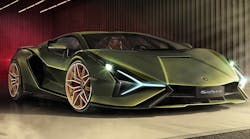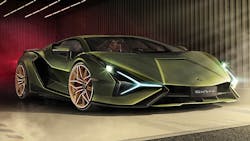Lamborghini Hybrid Uses Supercapacitors in Place of Batteries
Question: When is a mild hybrid not mild?
Answer: When the mild hybrid powertrain, defined as an internal combustion engine equipped with an electric motor/generator, puts out over 800 net horsepower, enabling the hybrid to reach a top speed of over 350 km/h (217.5 mph).
The Lamborghini Sián (pronounced “Shaan”) sports car, which debuted at the Frankfurt Auto Show last week, is the industry’s first supercapacitor-based hybrid. A 48-V e-motor delivering 34 hp is incorporated into the gearbox to provide immediate response and improved performance. This is claimed to be first application where a low-voltage hybrid has a direct connection between the electric motor and wheels, so that the e-motor can take on the strain during low-speed maneuvers such as reversing and parking. The Sián will not be able to travel under electrical power alone.
The car’s Sián moniker, meaning “flash or lightning” in Bolognese dialect, denotes the first electrification of a Lamborghini production car. While most hybrids use electric motors to downsize the accompanying gasoline engine, in this case Lamborghini combines it with a massive V12 engine. It incorporates titanium intake valves and is rated at 785 hp (577 kW) at 8,500 rpm—the highest output ever from a Lamborghini power plant. Combined with the additional 34 hp from the hybrid system, the Sián delivers a total of 819 hp (602 kW), enabling it to reach a top speed of over 350 km/h (217.5 mph).
Lamborghini’s Sián hybrid electric car can reach 60 mph in 2.8 seconds.
Supercap Array
Rather than a lithium-ion (Li-ion) battery, the Sián employs a supercapacitor array, which Lamborghini boasts is three times more powerful than a battery of equivalent weight. The company originally pioneered supercapacitor technology in its Lamborghini Aventador to provide added cranking power for efficient restarting of the 12-cylinder-engine vehicle.
While Li-ion batteries can store around 20 times more energy for their weight than supercapacitors, the battery’s flaw is that it takes time to discharge this energy due to resistance within the device. The fast movement of charge in supercapacitors is due to very low internal electrical resistance. In effect, this means they can be charged and discharged at high specific current values (A/kg) that may be over 100 times that of batteries, without damaging the unit.
Consequently, while a regular battery can handle around 2,000 to 3,000 charge and discharge cycles, supercapacitors can ideally last across millions of charge-discharge cycles without performance degradation. That’s because no physical or chemical changes occur when a charge is stored within them.
On the other hand, capacitors don’t have the energy storage density of batteries. Therefore, they don’t store nearly as much power as a battery of the same physical size.
As developed for the Sián, the supercapacitor array is said to be three times lighter than a battery producing the same power. The electric system with the supercapacitor and e-motor weighs only 34 kg, thus delivering a weight-to-power ratio of 1.0 kg/hp. A symmetric power flow ensures the same efficiency in both charging and discharging cycles. Located in the bulkhead between the cockpit and engine, it also enables a favorable overall vehicle weight distribution.
“Lamborghini is inherently a rule breaker, a challenger, always pushing what is possible to find a better solution,” says Maurizio Reggiani, Lamborghini’s Chief Technical Officer. “With the Sián, we are defining our route to innovation and we are setting new rules in new technologies, instead of just following existing solutions. The result is the Lamborghini Sián, which includes the world-first application of a supercapacitor for hybridization.”
Regenerative Braking
The Lamborghini Sián incorporates a newly developed regenerative braking system, a technology that recaptures the kinetic energy lost as heat when a car decelerates and turns it into electricity. Thanks to the behavior of the supercapacitor, which contrary to normal Li-Ion batteries can be charged and discharged with the same power, the Sián’s energy-storage system is fully charged every time the vehicle brakes.
Using the essentially free energy from the car’s brakes stored in the supercapacitor system, the electrical system helps get the car moving in tandem with the V12. The energy stored provides an instantly available power boost, allowing the driver to draw immediately on increased torque when accelerating away, up to 130 km/h (81 mph) when the e-motor automatically disconnects. As a result, it’s more than 10% faster than a car without this system.
The electrical energy system in the Sián is small to save weight (batteries are heavier than capacitors) and it's designed for power-assist scenarios rather than as a full-on hybrid power plant. It delivers rapid acceleration in low gears, with improved traction force provided by the combination of the V12 engine and the hybrid system. Traction force is said to be improved by up to 10% in third gear and the 30 to 60 km/h acceleration time is improved by 0.2 seconds compared to the company’s Aventador SVJ.
In higher gears and lower speeds, the electric motor increases traction force by up to 20%, reducing the 70 to 120 km/h acceleration by 1.2 seconds, again compared to the Aventador SVJ. This makes the Sián the fastest-accelerating Lamborghini ever, achieving 0 to 100 km/h in less than 2.8 seconds.
Want one? Only 63 Siåns will be made and they’re all accounted for—at a cost that’s rumored to be $3.6 million per.


